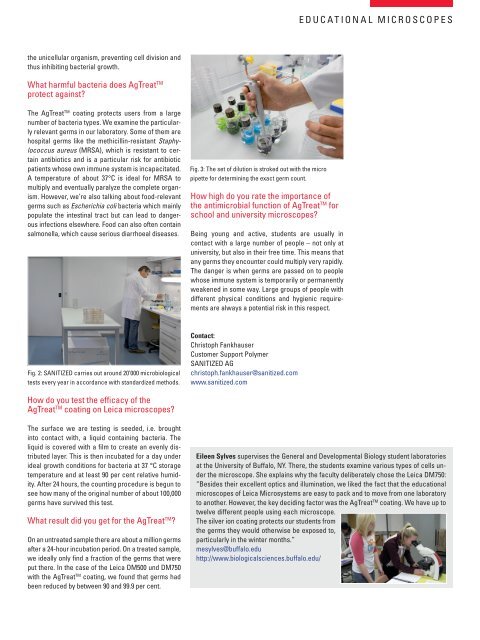A Contribution to Laboratory Hygiene
A Contribution to Laboratory Hygiene
A Contribution to Laboratory Hygiene
You also want an ePaper? Increase the reach of your titles
YUMPU automatically turns print PDFs into web optimized ePapers that Google loves.
the unicellular organism, preventing cell division and<br />
thus inhibiting bacterial growth.<br />
What harmful bacteria does agtreat tm<br />
protect against?<br />
the agtreat tm coating protects users from a large<br />
number of bacteria types. We examine the particularly<br />
relevant germs in our labora<strong>to</strong>ry. some of them are<br />
hospital germs like the methicillin-resistant Staphylococcus<br />
aureus (mrsa), which is resistant <strong>to</strong> certain<br />
antibiotics and is a particular risk for antibiotic<br />
patients whose own immune system is incapacitated.<br />
a temperature of about 37°c is ideal for mrsa <strong>to</strong><br />
multiply and eventually paralyze the complete organism.<br />
However, we’re also talking about food-relevant<br />
germs such as Escherichia coli bacteria which mainly<br />
populate the intestinal tract but can lead <strong>to</strong> dangerous<br />
infections elsewhere. Food can also often contain<br />
salmonella, which cause serious diarrhoeal diseases.<br />
Fig. 2: sanitiZed carries out around 20’000 microbiological<br />
tests every year in accordance with standardized methods.<br />
How do you test the efficacy of the<br />
agtreat tm coating on leica microscopes?<br />
the surface we are testing is seeded, i.e. brought<br />
in<strong>to</strong> contact with, a liquid containing bacteria. the<br />
liquid is covered with a film <strong>to</strong> create an evenly distributed<br />
layer. this is then incubated for a day under<br />
ideal growth conditions for bacteria at 37 °c s<strong>to</strong>rage<br />
temperature and at least 90 per cent relative humidity.<br />
after 24 hours, the counting procedure is begun <strong>to</strong><br />
see how many of the original number of about 100,000<br />
germs have survived this test.<br />
What result did you get for the agtreat tm ?<br />
on an untreated sample there are about a million germs<br />
after a 24-hour incubation period. on a treated sample,<br />
we ideally only find a fraction of the germs that were<br />
put there. in the case of the leica dm500 und dm750<br />
with the agtreat tm coating, we found that germs had<br />
been reduced by between 90 and 99.9 per cent.<br />
Fig. 3: the set of dilution is stroked out with the micro<br />
pipette for determining the exact germ count.<br />
How high do you rate the importance of<br />
the antimicrobial function of agtreat tm for<br />
school and university microscopes?<br />
Being young and active, students are usually in<br />
contact with a large number of people – not only at<br />
university, but also in their free time. this means that<br />
any germs they encounter could multiply very rapidly.<br />
the danger is when germs are passed on <strong>to</strong> people<br />
whose immune system is temporarily or permanently<br />
weakened in some way. large groups of people with<br />
different physical conditions and hygienic requirements<br />
are always a potential risk in this respect.<br />
Contact:<br />
chris<strong>to</strong>ph Fankhauser<br />
cus<strong>to</strong>mer support polymer<br />
sanitiZed aG<br />
chris<strong>to</strong>ph.fankhauser@sanitized.com<br />
www.sanitized.com<br />
educational microscopes<br />
Eileen Sylves supervises the General and developmental Biology student labora<strong>to</strong>ries<br />
at the university of Buffalo, nY. there, the students examine various types of cells under<br />
the microscope. she explains why the faculty deliberately chose the leica dm750:<br />
“Besides their excellent optics and illumination, we liked the fact that the educational<br />
microscopes of leica microsystems are easy <strong>to</strong> pack and <strong>to</strong> move from one labora<strong>to</strong>ry<br />
<strong>to</strong> another. However, the key deciding fac<strong>to</strong>r was the agtreat tm coating. We have up <strong>to</strong><br />
twelve different people using each microscope.<br />
the silver ion coating protects our students from<br />
the germs they would otherwise be exposed <strong>to</strong>,<br />
particularly in the winter months.”<br />
mesylves@buffalo.edu<br />
http://www.biologicalsciences.buffalo.edu/

















